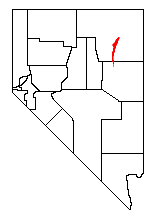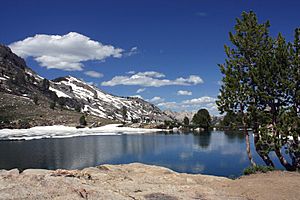Ruby Mountains facts for kids
Quick facts for kids Ruby Mountains |
|
|---|---|
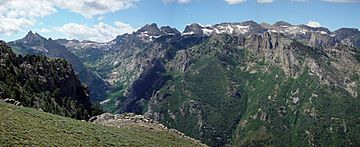
Peaks around Ruby Dome
|
|
| Highest point | |
| Peak | Ruby Dome |
| Elevation | 11,387 ft (3,471 m) |
| Dimensions | |
| Length | 80 mi (130 km) North-South |
| Width | 11 mi (18 km) |
| Geography | |
| Country | United States |
| State | Nevada |
| County | Elko |
The Ruby Mountains are a beautiful mountain range located mostly in Elko County, Nevada, United States. A small part of the range also reaches into White Pine County. Most of these mountains are part of the Humboldt-Toiyabe National Forest, a large protected area.
The highest point in the Ruby Mountains is Ruby Dome, which stands tall at about 11,387 feet (3,471 meters). The range stretches for about 80 miles (129 km) from north to south. To the east, you'll find Ruby Valley, and to the west are the Huntington and Lamoille Valleys. These mountains are special because they are the only place in North America where you can find the Himalayan snowcock, a type of bird that was brought here from Pakistan.
Early explorers named these mountains "Rubies" because they found garnets, which are red gemstones, in the area. The middle part of the Ruby Mountains shows many signs of past ice ages. You can see U-shaped canyons, rocky piles called moraines, and steep granite peaks and cirques. These features were carved by ancient glaciers. You can see many of these amazing sights from the 12-mile Lamoille Canyon Road, which is a special scenic drive.
Contents
Exploring the Ruby Mountains: Valleys, Peaks, and Lakes
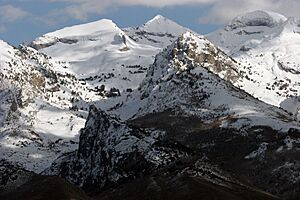
The Ruby Mountains have many interesting places to explore. Some of the main valleys include Lamoille Canyon (with its branches like Thomas and Right Fork Canyons), Seitz Canyon, Box Canyon, and Kleckner Canyon. Water from the northern canyons flows into the Humboldt River. Canyons near the Te-Moak tribal lands form the beginning of the South Fork of the Humboldt River.
Famous Peaks in the Rubies
Many tall mountains stand in the central part of the range. These include Ruby Dome, Thomas Peak, Liberty Peak, Mount Fitzgerald, Verdi Peak, Snow Lake Peak, Mount Silliman, and Mount Gilbert. Further south, you'll find King, Wines, Tipton, and Pearl Peaks. To the north of the main area are Old-Man-of-the-Mountain and Soldier Peak.
Beautiful Alpine Lakes
Long ago, glaciers dug out deep bowls in the mountains. These bowls are now filled with water, forming beautiful alpine lakes. The larger lakes in the central part of the range include Echo, Liberty, Favre, Lamoille, Castle, and Griswold lakes.
Smaller lakes, called tarns, are also found here. These include the scenic Island, Dollar, Verdi, Snow, Box, and Seitz lakes. Further north, you can find Cold, Hidden, Soldier, and Robinson lakes. To the south are North Furlong and Overland lakes. Water from the southern Ruby Mountains flows into the nearby Ruby Valley, creating the Ruby Lake National Wildlife Refuge.
Wildlife and Plants of the Ruby Mountains
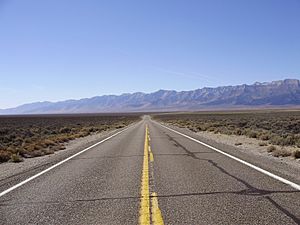
The eastern Great Basin, where the Ruby Mountains are, gets more rain than the western part. This is because the Sierra Nevada mountains block some of the rain from reaching the western side. The extra moisture in the Ruby Mountains helped create the large glaciers in the past. Today, it supports many different kinds of plants and animals.
Trees and Plants
At lower elevations, you'll see many aspen trees. As you go higher up the mountains, whitebark and limber pine trees become more common.
Animals of the Mountains
Many animals call the Ruby Mountains home. You might spot mountain goats, bighorn sheep, mule deer, and mountain lions. Smaller animals like marmots, beaver, and pikas are also common. As mentioned before, the Himalayan snowcock lives here, thriving among the high cliffs.
Fish in the Streams
The streams, especially on the western side, have native Lahontan or Humboldt cutthroat trout. However, some of these native fish have mixed with rainbow trout or have been replaced by brown and brook trout. These other types of trout were put into the streams for fishing before people fully understood how it would affect the native fish.
How the Ruby Mountains Were Formed
The Ruby Mountains are part of a larger area called the Basin and Range Province. This area formed when the North American plate stretched apart. Large cracks in the Earth's crust, called normal faults, on both sides of the mountains separate them from the flat valleys next to them.
The Ruby Mountains are a special type of mountain range called a metamorphic core complex. This means that rocks from deep inside the Earth's crust have been pushed up to the surface. You can see a special type of rock called mylonite along the western edge of the Ruby Mountains. This rock shows where the deep, changed rocks meet the younger, unchanged rocks around them. Generally, older and deeper rocks are seen more in the northern part of the Ruby Mountains than in the south.
Ruby Mountains Wilderness Area
The higher parts of the Ruby Mountains were named the Ruby Mountains Wilderness Area in 1989. This protected area covers about 90,000 acres (36,422 hectares). The isolated Seitz and Echo Canyons are also protected as a special Research Natural Area, which means they are kept safe for studying nature.
The Ruby Crest National Recreation Trail is a hiking path that goes for about 40 miles (64 km) from Harrison Pass northward to the Road's End Trailhead in Lamoille Canyon. You can usually get into the mountains for recreation at Lamoille and Soldier Canyons on the west side, and at the Overland Lake Trailhead to the east.
See also
 In Spanish: Montañas Ruby para niños
In Spanish: Montañas Ruby para niños


